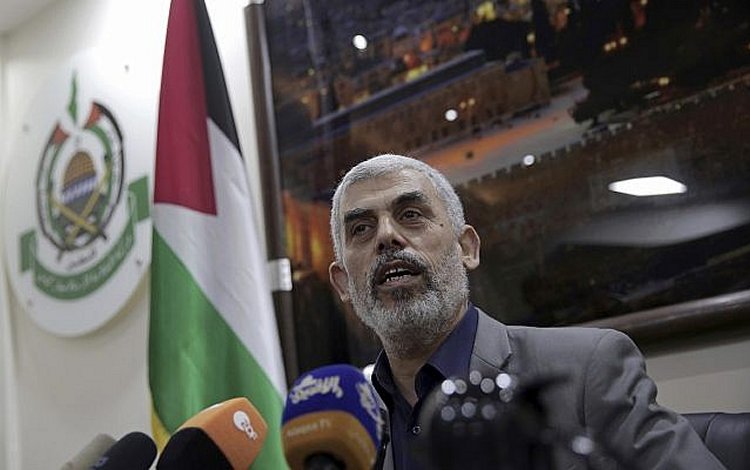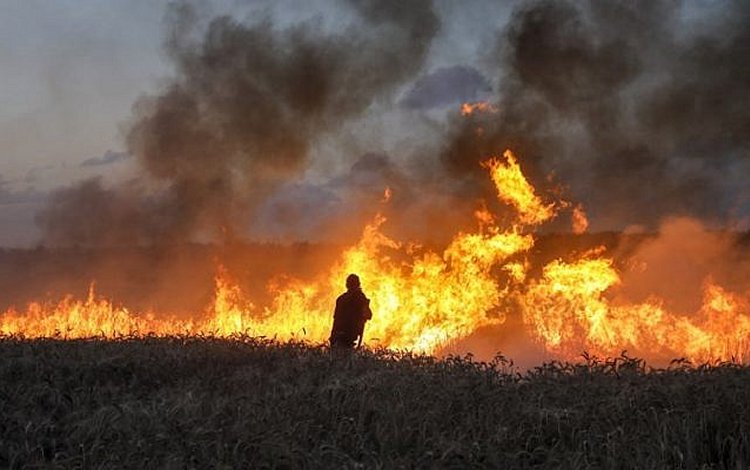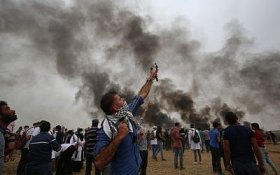
"What's the problem with hundreds of thousands breaking through a fence that is not a border?" asks Yahya Sinwar ahead of mass rallies next week

The Gaza leader of the Hamas said Thursday he hopes to see hundreds of thousands of Palestinians breach the border fence from Gaza into Israel at protests to coincide with next week’s US embassy move to Jerusalem.
In his first major briefing to international media since becoming head of the Gaza terror group in 2017, Yahya Sinwar implied he would like to see thousands of Palestinians crossing into Israel as part of the culmination of more than a month of protests.
Asked what he wanted to see from protests on Monday and Tuesday, Sinwar pointed out Israel has never specifically defined its borders.
“What’s the problem with hundreds of thousands breaking through a fence that is not a border?”
Sinwar said he hoped Israel would not shoot at what he called “peaceful” protests.
The Hamas-led demonstrations are ostensibly aimed to protest the decade-long Israeli-Egyptian blockade, imposed after the terror group seized power in Gaza in 2007, and to assert Palestinian demands for millions to “return” to lost properties in what is now Israel. Israel says, however, that the terror group uses the protests as a cover for attacks at the border and attempts to breach it.
Monday’s demonstration will cap six weeks of protests and coincides with the US move of its Israel embassy to Jerusalem and the date when Palestinians mark 70 years of “displacement.” Two-thirds of Gaza’s 2 million people are descendants of Palestinians who fled or were expelled from their homes during the war surrounding Israel’s establishment.
According to the Hamas health ministry, 48 Palestinians have been killed since protests and clashes began along the Gaza border on March 30 and hundreds of others have been wounded from gunfire. Israel says it only opens fire when necessary to stop infiltrations, damage to the fence, and attacks.
No Israelis have been hurt, and Sinwar said that was evidence the protests were “peaceful.”
But he warned the protests risked spiraling out of control. “The Gaza Strip is like a hungry tiger that has been starved and left in a cage for 11 years,” Sinwar said.
“Now the tiger is loose, and nobody knows what it will do.”
 Israeli firefighters attempt to extinguish a fire in a wheat field near the Kibbutz of Nahal Oz, along the border with the Gaza strip, on May 8, 2018, after it was caused by incendiaries tied to kites flown by Palestinian protesters from across the border. (AFP/Menahem Kahana) |
On Wednesday, Sinwar said the mass protest will be “decisive,” vowing that he and other top officials were “ready to die” in a campaign to end Israel’s decade-old blockade of the territory. Israel maintains the blockade to prevent Hamas, a terror group that seeks to destroy Israel, from importing weaponry.
In a speech to hundreds of Gazan youths, he said Hamas has rejected international proposals to stop the weekly, often violent gatherings.
“We can’t stop these protests. We are supporting, even leading, them,” he said. The protests will be “like a tiger running in all directions,” he said.
Going further, he said Hamas leaders “are ready to die along with tens of thousands” as the marches climax next week.
Activists have been burning tires along the fence, throwing stones at Israeli troops, and flying incendiary kites over dry fields on the Israeli side of the border in recent Fridays. Some of the youths brandished wire cutters, a popular tool in weekly attempts to cut through the border fence.
An Islamist terror group which seeks to destroy Israel, Hamas violently took control of Gaza from Mahmoud Abbas’s Fatah in 2007, two years after Israel withdrew its military and civilian presence from the Strip. Israel and Egypt maintain a security blockade of Gaza. Israel says this is vital to prevent Hamas — which has fought three rounds of conflict against Israel since seizing Gaza, firing thousands of rockets into Israel and digging dozens of attack tunnels under the border — from importing weaponry.
Hamas acknowledged that five of its terrorists were among the fatalities after the first Friday demonstration, but has since refrained from acknowledging whether its men are among the dead. Israel has identified other fatalities as members of terrorist groups.
 A Palestinian man uses a slingshot during weekly protests along the Gaza border near the city of Khan Younis on May 4, 2018. (Said Khatib/AFP) |
The Israeli military has faced international and domestic criticism over its use of live fire, with the United Nations and European Union calling for an independent investigation rejected by Israel.
Israel says Hamas uses the marches as cover for terrorist attacks.
Israel has repeatedly expressed concern over the possibility of a mass breach of the Gaza fence, in which Palestinians would stream across with terrorists among them, wreaking havoc. Sinwar has vowed in the past that protesters would “breach the borders and pray at Al-Aqsa,” referring to the major Muslim shrine in Jerusalem.
Sinwar was freed in a prisoner swap with Israel in 2011 and was elected as the movement’s Gaza chief in 2017.
Hamas has said if the protests “don’t achieve their goals,” they will continue.
At previous peace talks, the Palestinians have always demanded, along with sovereignty in the West Bank, Gaza, East Jerusalem, and the Old City, a “right of return” to Israel for Palestinian refugees who left or were forced out of Israel when it was established. The Palestinians demand this right not only for those of the hundreds of thousands of refugees who are still alive — a figure estimated in the low tens of thousands — but also for their descendants, who number in the millions.
No Israeli government would ever be likely to accept this demand, since it would spell the end of Israel as a Jewish-majority state. Israel’s position has generally been that Palestinian refugees and their descendants would become citizens of a Palestinian state at the culmination of the peace process, just as Jews who fled or were forced out of Middle Eastern countries by hostile governments became citizens of Israel.